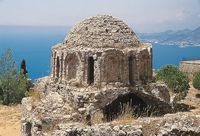Alanya Castle was built in the 13th century, following the Seljuk conquest under Sultan Alaaddin Keykubat I. There are 6.5 km of walls, with 93 towers, 140 battlements and 400 cisterns. The Inner Fortress stands 250 metres above sea level, and offers spectacular views over the town.
History
Alanya Castle was built in the 13th century, following the city's conquest in 1221 by the Seljuk Sultan Alaaddin Keykubat I. Prior to the conquest, the city was known as Kalonoros. The Sultan promptly renamed it Alaiye, in honour of himself, and made it his winter capital and Mediterranean naval base. The Sultan’s building programme included the walls, Citadel (also known as the Inner Fortress), The Red Tower, the Dockyard and the Arsenal. Because stone from previous buildings was re-used, a Sultan’s Palace was completed about 3 years after the conquest.
After the area was pacified under the Ottoman Empire, the castle ceased to be purely defensive. Settlements were built inside the outer wall, and many traditional Ottoman houses were built there in the 19th century.
Geography and archaeology
The area of the Outer and Middle Fortresses, which stretches from the outer wall up to the Citadel, is a fascinating area for visitors to freely explore.
The Citadel is built 250 metres up, at the highest point of the rocky peninsula that juts out into the Mediterranean Sea. The sea protects it on three sides. It was built on the remnants of earlier Byzantine and Roman fortifications. Many of the cisterns are in good condition. Significant buildings inside the citadel include the Cold Water Bath and an old Christian Basilica.
Key Facts
- Alanya Castle was added to UNESCO’s World Heritage Tentative List in 2009.
- The walk from the centre of Alanya up to the Citadel is a moderate one for hikers, but it is probably too strenuous for most visitors.
- Efforts have been made to make the Citadel accessible to those with disabilities. However, those with walking difficulties will find some parts to be inaccessible.
- Alanya was accepted into membership of The World Union of Cities with Castles, which has 140 members from 26 countries, on 12 October 2009. It is also a member of the Walled Towns Friendship Circle.
- Admission: there is a charge for admission to the Citadel.
Shorex: ideal half day; combines well (with any combination of 3, 4, 5 & 6) for full day.





